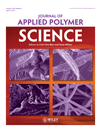Synthesis and curing properties of a novel curing agent based on N-(4-hydroxyphenyl) maleimide and dicyclopentadiene moieties
Abstract
A new type of epoxy resin curing agent, containing pendant phenol functions, was synthesized by the free-radical copolymerization of N-(4-hydroxyphenyl) maleimide with dicyclopentadiene (DCPD) monomer in the presence of a radical initiator. The chemical structure was characterized with Fourier transform infrared spectroscopy and nuclear magnetic resonance. The molecular weight of the new curing agent was determined by gel permeation chromatography. The activity and activation energy of this new curing agent with o-cresol formaldehyde novolac epoxy (CNE) was investigated with a nonisothermal differential scanning calorimetry technique at different heating rates. The thermal properties of the cured polymers were evaluated with thermogravimetric analysis, and the results exhibit good thermal stability. In addition, this new curing agent with CNE showed low moisture absorption because of the hydrophobic nature of the DCPD structure. © 2010 Wiley Periodicals, Inc. J Appl Polym Sci, 2011




